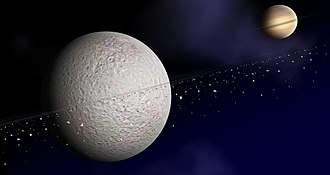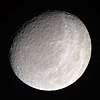Subsatellite
.tif.jpg)
(artist concept)[1][2]
A subsatellite is a natural satellite (or an artificial satellite) that orbits a natural satellite, i.e. a "moon of a moon", which is also known as a moonmoon, moon moon or submoon.[3][4][1][5][6][7][8]
It is inferred from the empirical study of natural satellites in the Solar System that subsatellites may be elements of planetary systems. In the Solar System, the giant planets have large collections of natural satellites (see Moons of Jupiter, Moons of Saturn, Moons of Uranus and Moons of Neptune). The majority of detected exoplanets are giant planets; at least one, Kepler-1625b, may have a very large exomoon, named Kepler-1625b I.[1][2][9][10][11][12] Therefore, it is reasonable to assume that subsatellites may exist in the Solar System, and in planetary systems beyond the Solar System.
Nonetheless, no "moon of a moon" or subsatellites (natural satellites that orbit a natural satellite of a planet) are currently known as of 2018 in the Solar System, or beyond the Solar System. In most cases, the tidal effects of the planet would make such a system unstable.
Rhea
The possible detection[13] of a ring system around Saturn's natural satellite Rhea led to calculations that indicated that satellites orbiting Rhea would have stable orbits. Furthermore, the suspected rings are thought to be narrow,[14] a phenomenon normally associated with shepherd moons. However, targeted images taken by the Cassini spacecraft failed to detect any moonlet associated with Rhea.
Iapetus
It has also been proposed that Saturn's satellite Iapetus possessed a subsatellite in the past; this is one of several hypotheses that have been put forward to account for its equatorial ridge.[15]
Artificial subsatellites
Many spacecraft have orbited the Moon, including manned craft of the Apollo program. As of 2018, none have orbited other moons. The Soviet Union unsuccessfully tried to put two unmanned probes on quasi-satellitary orbits around the Martian moon Phobos.
See also
References
- 1 2 3 Forgan, Duncan (4 October 2018). "The habitable zone for Earthlike exomoons orbiting Kepler-1625b". arXiv:1810.02712v1 [astro-ph.EP].
- 1 2 Chou, Felcia; Villard, Ray; Hawkes, Alison; rown, Katherine (3 October 2018). "Astronomers Find First Evidence of Possible Moon Outside Our Solar System". NASA. Retrieved 11 October 2018.
- ↑ Starr, Michelle (11 October 2018). "You'll Never Guess What Scientists Want to Call The Moon of a Moon - Can moons even have moons?". ScienceAlert.com. Retrieved 11 October 2018.
- ↑ Kollmeier, Juna A.; Raymond, Sean N. (8 October 2018). "Can Moons Have Moons?". arXiv:1810.03304v1 [astro-ph.EP].
- ↑ Crane, Leah (10 October 2018). "Moons can have moons and they are called moonmoons". New Scientist. Retrieved 11 October 2018.
- ↑ Frost, Natasha (10 October 2018). "Guess what scientists call the moons of moons". Quatrz. Retrieved 11 October 2018.
- ↑ Daley, Jason (11 October 2018). "If a Moon Has a Moon, Is Its Moon Called a Moonmoon? - A new study suggests it's possible some moons could have moons and the internet wants to give them a name—but scientists have yet to actually find one". Smithsonian. Retrieved 12 October 2018.
- ↑ Chong, Zoey (11 October 2018). "No one's ever seen a moonmoon, but the internet already loves it - Let the memes begin". CNET. Retrieved 11 October 2018.
- ↑ Teachey, Alex; Kipping, David M. (3 October 2018). "Evidence for a large exomoon orbiting Kepler-1625b". Science. 4 (10). doi:10.1126/sciadv.aav1784. Retrieved 11 October 2018.
- ↑ http://exoplanet.eu/catalog/kepler-1625_b_i/
- ↑ Drake, Nadia (3 October 2018). "Weird giant may be the first known alien moon - Evidence is mounting that a world the size of Neptune could be orbiting a giant planet far, far away". National Geographic Society. Retrieved 11 October 2018.
- ↑ "Hubble finds compelling evidence for a moon outside the Solar System - Neptune-sized moon orbits Jupiter-sized planet". SpaceTelescope.org. Retrieved 11 October 2018.
- ↑ "The Dust Halo of Saturn's Largest Icy Moon, Rhea – Jones et al. 319 (5868): 1380 – Science". Retrieved 12 October 2018.
- ↑ "Saturn satellite reveals first moon rings – 06 March 2008 – New Scientist". Retrieved 12 October 2018.
- ↑ "How Iapetus, Saturn's outermost moon, got its ridge". Retrieved 12 October 2018.
External links
![]()
- Shadow Moons: The Unknown Sub-Worlds that Might Harbor Life
- Likely First Photo of Planet Beyond the Solar System
- Working Group on Extrasolar Planets – Definition of a "Planet" Position statement on the definition of a planet. (IAU)
- The Hunt for Exomoons with Kepler (HEK): I. Description of a New Observational Project

